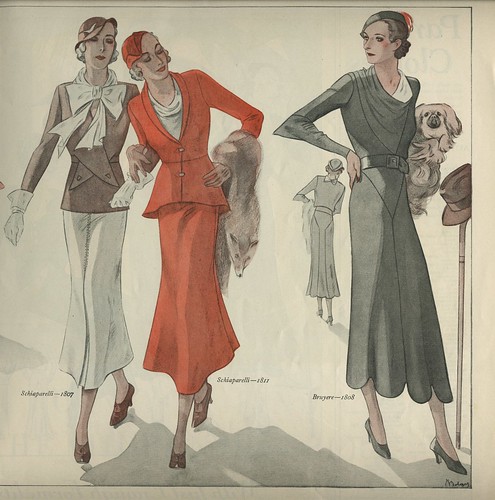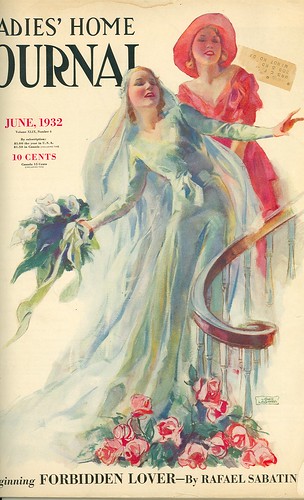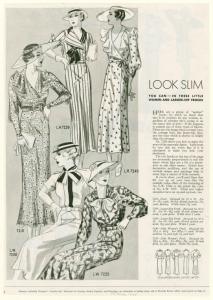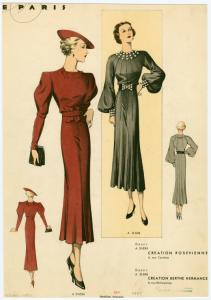Things I love about this article:
- ‘Them’ is used as a (relatively) good term
- Lots of fabric history!
- Fabrics named ‘Billowee’ and ‘Krinkle Krepe’ are considered elegant in comparison to ‘Necking Time’ and ‘Razzle Dazzle’
- “It was not exactly something new; it was merely old enough to seem new”
Reprinted from Times Magazine, Monday September 12, 1932
The U. S. silk industry, to its intense delight, last week found itself suddenly in the midst of a boom. Unlike cotton and woolen men, silk men are much at the mercy of THEM and last week it was gloriously plain that THEY–the fashion designers of Paris, the style buyers and editors from the U. S., and the 40,000,000 U. S. women who wear dresses–had decided on a style change which would require the U. S. silk industry’s most diligent services.

Schiaparelli and Bruyere in 1932
THEY do not decide all of a sudden. The blessed event which now delights silk men really began last February when the U. S. style buyers found nothing to excite them at the Paris salons and bitterly said so, threatening never to come back. Oh, please come back next summer! begged Vionnet, Lanvin, Patou, Schiaparelli, Chanel, et al., and promised faithfully to have something that would surely start a U. S. fad, a wave of buying under the irresistible pressure of Fashion.
The U. S. buyers last month went back to Paris skeptically. Sure enough, word soon went around the silk industry’s lunch tables that something had been found. It was not exactly something new; it was merely old enough to seem new. It was Rough Crepe, which takes more silk fibre per yard than any other silk dress stuff. Crepe de Chine has not been “in” for years, rough crepes have never been popular. Few wardrobes would contain old crepe de Chine dresses, let alone rough crepes, that could be made over. Silk men know that there are 10,000,000 U. S. women who have never had a silk dress. Perhaps 5,000,000 more cannot now afford to buy one, though a silk dress that cost $25 in 1929 will cost but $10 this year. Even so that leaves 20 or 25 million women who will feel they must, and therefore will, have at least one crepe dress almost right away. That was the beauty of it. When THEY decide, things move quickly.

Classical fashions for spring 1932, Vogue
Silk men say that a silk fad sweeps the world about every ten years. Creeping out of the post-War slump, in 1922 the silk industry was whipped to prosperity by a huge and sudden demand for crepe de Chine. It replaced taffeta, which had clung on tenaciously from the billowy era at the turn of the century, as the standard dress silk. When the good news came last month, silk mills had little rough crepe in stock. So great and so urgent was the demand that silk men last week were vainly trying to buy from each other to satisfy orders. A good part of the silk & rayon industry’s 125.000 operatives had already trooped back to re-opened mills. Consumption of raw silk last month jumped to 60,000 bales–up 29% from last year and the highest monthly taking in nearly two years. Japanese farmers clop-clopped about their sericulture more cheerfully, for the sudden demand had shot raw silk prices 82% above the June low of $1.10 a pound.
Rough crepe is an old silk product but the demand for it has always been nominal. All crepes are woven on large looms with some threads highly twisted. When the cloth is removed these threads tend to untwist, giving it a rough or pebbly appearance. Rayon, though not so elastic as silk, is also used for crepes and rayon mills are sharing in the present boom.

Ladies Home Journal, 1932
Most popular colors, silk men think, will be Harvard red, followed by black, olive green and royal blue. Trade names for some of the rough crepes include Bagheera, Billowee, Bubble crepe, Krinkle Krepe. Less elegant are two new silk fabrics, Necking Time and Razzle Dazzle.
Largest maker of dress silks is Stehli Silks Corp. Susquehanna, Schwarzenbach Huber & Co., Cheney Bros., C. K. Eagle are all large silk makers, but their business is less specialized. In 1929 Stehli sold 14,000,000 yards–enough for 5,000,000 dresses. About three-fourths was sold to dress manufacturers, one-fourth to stores for over-the-counter distribution. Their annual volume is nearly $25,000,000. The business was founded by Statthalter Rudolph Stehli in Obfelden, Switzerland, in 1837, has remained in the family ever since. The company now has 3, 500 looms scattered through Switzerland, Italy, Germany and the U. S. Emil J. Stehli, grandson of the founding Statt halter and president of Stehli Silks Corp., came to the U. S. in 1897 to establish an importing house as an adjunct to Zurich’s Stehli & Co. Importing of Stehli silks proved profitable until the Dingley tariff ended it forever. As U. S. manufacturers do today in foreign lands, the resourceful Stehlis promptly started manufacture of silks safe within the tariff wall. Now the U. S. branch of the family business is four times as large as the sturdy Swiss parent. Of the fourth generation is blond, pink-cheeked Henry E. Stehli, able young secretary and treasurer of Stehli Silks Corp. To reap the harvest of rough crepe Stehli has recalled 2,000 workers, its mills have been stepped up to three shifts. Production in anticipation of another silk year is running 25% above rated capacity.

French fashions in 1933




Excellent article! Thanks for sharing this!
This is a fabulous article! The photos are also great! The styles of the early 30s are so graceful and classic. I am much to tempted by every good pattern I see!
Wow that last illustrations goes to show the lollipop ladies isn’t a new fashion phenomenon after all!
Ooooooh!
That was a good read! (and I just love “It was not exactly something new; it was merely old enough to seem new”)
…I also feel that Harvard Red is just a stunning colour…..
The green square neck with the buttons!! Even on a clothes-peg model! Wow! Great article. “The Silk Men” – love it. We’ve had the Straw Men and the Wooden men and the Tin Man – but the Silk Men! Spin on, boys!
Oh, I do love the lines and detailing of 1930s dresses. The drape and cut of the skirts is to die for. Bring on the silk crepe!